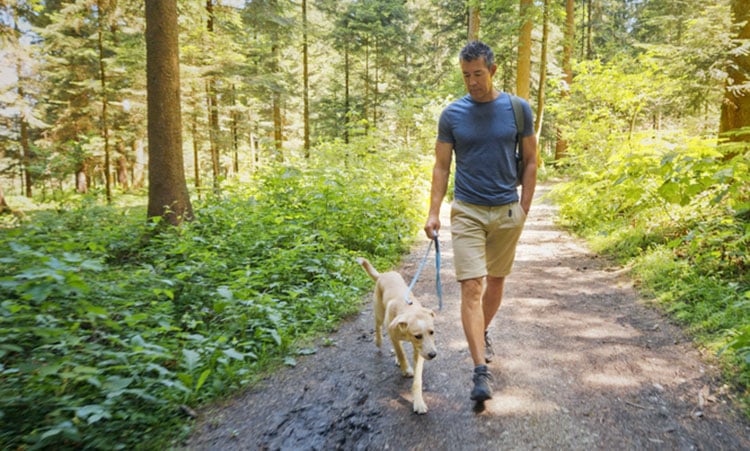Key Takeaways
• Most dogs need daily walks for their physical and mental health.
• How much your dog needs to walk will depend on breed, age, and whether they have a medical condition.
• There are a few exceptions that might prevent daily walks, such as extreme weather, or a dog’s medical condition. In these cases, there are some exercise alternatives to walking.
Table of Contents
You probably know that dogs love walks and need them for their physical and mental health. Here are a few of the benefits of dog walking:
- Walking your dog keeps them fit, strengthens their heart, and helps avoid obesity and related health problems, such as arthritis and a shortened lifespan.
- A daily walk is essential for socializing dogs with other dogs and people you will encounter during the walk.
- Walking your dog – probably their favorite activity — will improve the bond between you.
- You can use walks to train your dog to walk nicely on a leash, learn the “leave it” command, practice recall, and more.
- Walking fulfills dogs’ need to explore their world. Their ancestors spent most of their waking hours hunting or foraging, and this is an instinct that remains in modern dogs. That’s why it’s also vital to allow dogs to sniff and linger if there is something they are interested in.
- Dogs need to relieve themselves – pee and poop – and some dogs will do so only away from home.
- Walking can help prevent behaviors that result from not getting enough exercise and being anxious. These behaviors include excessive barking, destructive chewing, digging, hyperactivity, and running roughshod through the house.
Dog walking is also beneficial for humans’ physical and mental health; studies show it can reduce anxiety and depression. One study found that dog walkers walked an average of an hour more per week than pet parents who did not walk their dogs, improving their cardiovascular health.
How long should you walk your dog?
Now that you know the benefits of daily walking, you may need clarification about how often and how far you should walk your dog. The answer depends greatly on your dog’s breed, health, age, and personality. Generally, dogs should get between 30 minutes and two hours of exercise daily.
While letting your dog out in the yard will give them a little stimulation, dogs won’t usually exercise themselves, which is why walks are essential. Take our quiz to see if you are exercising your dog enough.
How your dog’s breed affects their need for exercise
The dog’s breed plays a significant role in determining how much they need walking or other exercise.
High-energy breeds
Sporting or herding breeds such as border collies and German shorthair pointers will have the most energy to burn, says the American Kennel Club.
Ideally, these super-active breeds need to be walked at least twice daily for 30-60 minutes each. If your dog gets along well with other dogs, you can supplement the walks with outdoor play in a yard or a dog park. If you are the outdoorsy type, these dogs would love to go on a hike with you.
Low-energy or flat-faced breeds
Low-energy breeds include the bulldog (English or French), bichon frise, and a Boston terrier. Many of these breeds are also brachycephalic or flat-faced and can’t breathe normally. Therefore, they will not want to exert themselves too much.
These breeds would do well with only a couple of 15-minute casual walks or one 30-minute walk each day, with lots of opportunities for sniffing and exploring.
Mixed-breed dogs
For mixed-breed dogs, you will need to assess, based on their size and behavior, how much exercise they need. Your veterinarian can advise you or provide an educated guess on the make-up of breeds they likely are. You could also purchase a DNA test to learn your dog’s genetic lineage and discuss the results with your veterinarian.
How your dog’s age affects their need for exercise
Along with breed, your dog’s age will determine how much energy they have. Many dogs are happy to walk longer distances well into their senior years, especially if they have remained fit throughout their life.
How much walking does a puppy need?
Puppies generally have more energy than adult dogs, but it’s better to have several short walks or play sessions during the day. They tend to have bursts of energy and may get the zoomies where they race around madly for a short time.
Long walks can be strenuous on a puppy’s developing body. Initially, keep walks to about 20 minutes.
Walks are necessary for puppies to start socializing them and start some basic obedience training as you encounter people and dogs along the way.
How much walking does an adult dog need?
Once your dog is fully grown, you can take them on longer walks (30+ minutes), but how long will depend on your dog. Many of the athletic types will enjoy long runs or full day hikes, while other breeds do better with short walks.
Some dogs are great at communicating when they are loving their walk and want to go further (leash pulling, wagging tail), or whether they are tired and want to go home. Observe your dog and learn how to read their body language to see if they are enjoying the walk.
How much walking does a senior dog need?
Senior dogs will slow down and may not be able to run like they once did, but daily walks are just as enriching for them unless they have a medical condition that prevents it. Even if your walks are slow or short, the mild exercise and fresh air are favorable for your dog’s health. An older dog with no injuries or medical conditions will be fine with slow or moderate 30-minute to one-hour walks. Again, observe your dog and cut the walk short if they seem tired.
Medical conditions that prevent walking
Dogs recovering from surgery or suffering from arthritis, hip dysplasia, joint issues, or heart or respiratory issues may not be able to walk much. If your dog has any of these conditions, ask your vet about an appropriate exercise routine to keep them healthy. If your dog is willing to go and your vet approves, short walks with a chance to go potty will still be rewarding for them.
When to limit or not walk your dog
You will need to consider if extreme weather – whether hot, cold, or just plain dangerous – should shorten or limit your dog walks. Generally, if the outdoor temperature is too hot or cold for you, it’s probably too severe for your dog.
When it’s frigid
How well your dog tolerates the cold depends on their breed, weight (how much body fat), and how thick their coat is. A Husky will be thrilled in below-freezing temperatures, while a chihuahua will be miserable. You and your dog will warm up as you walk but avoid walking in dangerously low temperatures or keep the outing short.
In general, most dogs are okay until the temperature drops to below 45°F, according to PetMD. Below that, some dogs may begin to feel uncomfortable. Below freezing (32°F), dogs in sensitive categories, such as older dogs and those with thin coats, would benefit from a jacket or sweater. Temperatures below 20°F are not safe for any dog to spend significant amounts of time outside, due to the risks of hypothermia and frostbite.
Consider purchasing booties to keep your dog’s paws warm and out of direct contact with the asphalt when it’s frigid outside. Also, keep in mind that small and toy breeds tend to lose body heat very quickly; a jacket or sweater is a must for these dogs during the winter months.
When it’s sweltering
How hot is too hot for a dog walk will depend again on the dog’s breed and humidity levels. In an arid climate, some dogs will be comfortable at temperatures of 85°F and can walk slowly as long as you bring water. However, a dog in a high-humidity environment at the same temperature might be in danger of heatstroke. Flat-faced and thick-furred dogs will be more susceptible to heat than others. Any temperature above 90°F will be too hot for most dogs.
On extreme heat days, walk your dog in the early morning or late evening when temperatures cool off. Place your hand on the sidewalk first to ensure it’s not hot enough to burn the sensitive pads on your dog’s feet. If the sidewalk feels too hot, try to walk your dog on the grass as much as possible.
Getting your dog wet before the walk will keep them cool for the first portion of your time outside.
After your walk, give your dog plenty of time to cool off inside and make sure they have access to fresh, cool water.
When there is a smoke advisory
People on the west coast have become accustomed to smoke advisories from wildfires in the summer or fall. If the air is rated hazardous to humans, it’s not healthy for dogs. Try to find some indoor activities to entertain your dog.
If there is a natural disaster that makes going out hazardous
Avoid walking outside in the case of extremely high winds, flooding, a blizzard, tornadoes, or other natural disasters that authorities warn are unsafe. And, be sure you are prepared to protect your pet in case of an evacuation.
Alternatives to walking your dog
If you cannot walk your dog for some reason, such as a disability, there are other ways to ensure your dog gets enough exercise.
For arthritic dogs or those with joint issues, swimming can be an excellent alternative for movement if they like the water. The water will support them and keep weight off their joints when they swim.
If your dog is healthy but can’t go for a walk because of weather or other reasons, some games and activities will get their blood flowing, such as fetch, tug-o-war, or an indoor obstacle course.
If the pet parent is the one with a disability that prevents walking, consider asking a friend or family member to walk the dog or hire a dog walker for daily walks.












